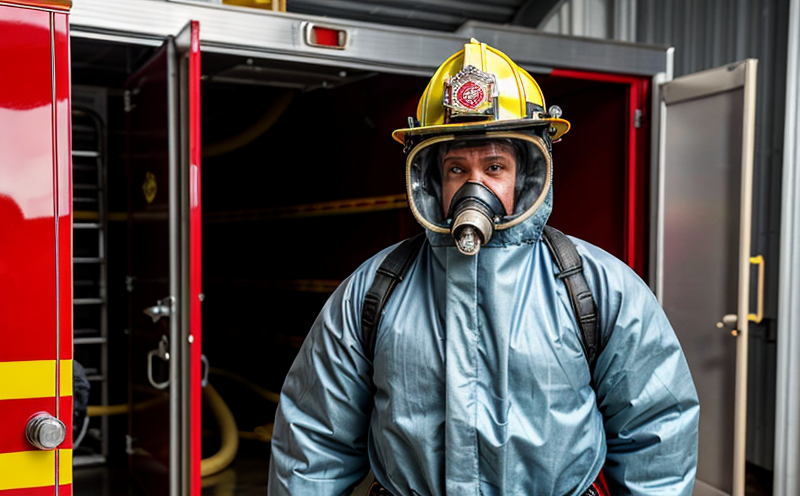Firefighter Clothing Lifecycle Durability Testing
The lifecycle durability testing of firefighter protective clothing is a critical aspect of ensuring that these garments meet stringent safety and performance requirements. This comprehensive testing not only verifies the initial quality but also evaluates how well the garment will withstand repeated use under realistic conditions. Quality managers, compliance officers, R&D engineers, and procurement teams rely on such tests to ensure they are providing firefighters with the best possible protection.
Firefighter protective clothing is subjected to a wide range of environmental and operational stresses during its lifecycle. This includes exposure to high temperatures, flame impingement, water immersion, abrasion, and chemical contamination. The durability testing aims to simulate these conditions accurately so that any potential weaknesses in the garments can be identified early on.
The testing process begins with meticulous specimen preparation. Samples of the clothing are cut according to specific standards and protocols. These samples are then subjected to various tests designed to mimic real-world usage scenarios. For instance, flame resistance is tested using methods like the ASTM F1959 standard, which measures the time it takes for a fabric sample to ignite and continue burning after being exposed to a flame.
Another crucial test is the thermal protective performance (TPP) evaluation, which assesses how well the clothing protects against heat. This is done using the NFPA 1971-2018 standard, which provides guidelines for testing the thermal protective properties of protective clothing and equipment. The results of these tests are analyzed to determine if the clothing meets the required performance criteria.
Water resistance is also a key factor in firefighter protection. Tests such as those outlined in ASTM F963-20 help ensure that the garments can withstand water pressure without leaking, which is essential for protecting firefighters from both water and heat at the same time. Abrasion tests simulate the wear and tear that clothing undergoes during normal use, ensuring that it remains intact even after multiple washings.
Chemical resistance testing ensures that the fabric used in firefighter protective clothing can withstand exposure to various chemicals without breaking down or losing its protective properties. This is particularly important for firefighting operations where firefighters may be exposed to a wide range of hazardous materials.
The results from these tests are meticulously recorded and analyzed, providing valuable insights into the durability and safety of the clothing throughout its lifecycle. This information helps manufacturers improve their products and ensures that firefighters have the best possible protection when performing their duties.
By conducting rigorous lifecycle durability testing, laboratories ensure that firefighter protective clothing meets not only current regulations but also future demands for enhanced performance. These tests play a vital role in maintaining public safety by providing firefighters with garments that are reliable and durable under the most demanding conditions.
Applied Standards
| Standard | Description |
|---|---|
| NFPA 1971-2018 | This standard specifies the minimum performance requirements for structural protective clothing and equipment for firefighters. It covers various aspects including flame resistance, thermal protective performance, and chemical resistance. |
| ASTM F1959 | The standard test method for measuring the time it takes for a fabric sample to ignite and continue burning after being exposed to a flame. This is part of the flame resistance testing process. |
| ASTM F963-20 | This standard provides guidelines for testing the water resistance properties of protective clothing, ensuring that it can withstand high-pressure water jets without leaking. |
| AWS A1.5/AWJ 1.5-2020 | These standards provide specifications and test methods for the abrasion resistance of fabrics used in firefighting garments. |
Industry Applications
| Application | Description |
|---|---|
| NFPA 1975-2020 | This standard provides guidelines for the selection, care, and maintenance of protective clothing. It ensures that firefighters have access to properly maintained garments that meet all relevant standards. |
| ISO 13685:2020 | This international standard specifies requirements for the design, manufacture, testing, and use of firefighting protective clothing. It helps ensure consistent quality across different manufacturers. |
| EN ISO 24092-1/2 | The European standards provide additional layers of protection by specifying performance criteria for thermal insulation and chemical resistance in firefighter protective clothing. |
| ASTM F1506 | This standard covers the testing methods for determining the electrical properties of fabrics used in protective clothing, ensuring they are safe to use around electricity. |
Environmental and Sustainability Contributions
The lifecycle durability testing of firefighter protective clothing contributes significantly to environmental sustainability. By ensuring that the garments meet stringent performance requirements, these tests help reduce waste by extending the useful life of each piece of equipment. This means fewer replacements are needed, which in turn reduces the overall environmental impact associated with manufacturing and disposing of protective clothing.
Additionally, the testing process itself plays a role in promoting sustainability by identifying any areas where improvements can be made to enhance performance while minimizing resource use. For example, manufacturers may explore more sustainable materials that still meet the necessary standards but have a lower carbon footprint or are easier to recycle at the end of their lifecycle.
The durability tests also help ensure that firefighters have access to equipment that is not only safe and effective but also environmentally responsible. This aligns with broader efforts within the fire service to adopt more sustainable practices, ultimately contributing to a safer and healthier environment for all.





